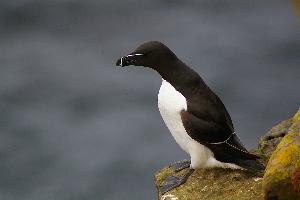
Váhy a míry
| Délka | od 26 do 29 cm |
|---|---|
| Délka rozpětí křídel | od 47 do 63 cm |
Popis zvířete
The Atlantic puffin, scientifically known as Fratercula arctica, is a captivating and distinctive seabird that inhabits the northern Atlantic Ocean. This species is part of the auk family, Alcidae, and is renowned for its striking appearance and unique behaviors. The Atlantic puffin is a bird of moderate size, typically measuring about 30 centimeters in length and weighing approximately 500 grams, with a wingspan that spans around 50 to 60 centimeters.One of the most remarkable features of the Atlantic puffin is its colorful bill, which is large, broad, and brightly colored during the breeding season. The bill's vivid hues of orange, blue, and yellow make it one of the most distinctive beaks in the avian world. This colorful bill contrasts sharply with the bird's predominantly black and white plumage. The puffin's face is mainly white, with a black crown and back, giving it a somewhat clown-like appearance that has endeared it to many.
Atlantic puffins are well adapted to life at sea. Their bodies are streamlined for swimming, with short wings that are used both for flying and for propelling through the water. Underwater, they use their wings in a flying motion to chase after fish, their primary food source. Puffins are excellent divers and can reach depths of up to 60 meters in pursuit of fish, such as sand eels, herring, and capelin.
Breeding season brings Atlantic puffins to coastal cliffs and offshore islands, where they form large, dense colonies. These birds are monogamous and often return to the same burrow year after year to breed with the same partner. The female lays a single egg, which both parents take turns incubating. After hatching, the chick, known as a puffling, is fed by both parents until it is ready to fledge and make its way to the sea.
Communication among Atlantic puffins is achieved through a variety of vocalizations and body displays. Their most common sound is a deep, throaty growl emitted from their burrows. During the breeding season, puffins are more vocal, using a range of sounds to communicate with their mates and neighbors.
Despite their widespread popularity and the fascination they hold for many birdwatchers and nature enthusiasts, Atlantic puffins face several threats. Overfishing has reduced their food sources, while climate change impacts the availability and distribution of fish stocks. Additionally, introduced predators on breeding islands can significantly affect puffin populations. Conservation efforts are ongoing to protect their habitats, regulate fishing practices, and remove invasive species from breeding sites.
The Atlantic puffin is not only a symbol of the rugged and beautiful landscapes where it makes its home but also a reminder of the interconnectedness of ecosystems and the importance of conservation efforts to maintain the biodiversity of our planet.
Podobná zvířata
Nové fotografie zvířat
Top 10 zvířat
- Dolphin gull (Leucophaeus scoresbii)
- Diana monkey (Cercopithecus diana)
- Moustached guenon (Cercopithecus cephus)
- Galápagos tortoise (Geochelone nigra complex)
- Stone loach (Barbatula barbatula)
- Japanese macaque (Macaca fuscata)
- Russian tortoise (Testudo horsfieldii)
- Greek tortoise (Testudo graeca)
- Common flying dragon (Draco volans)
- Vendace (Coregonus albula)


